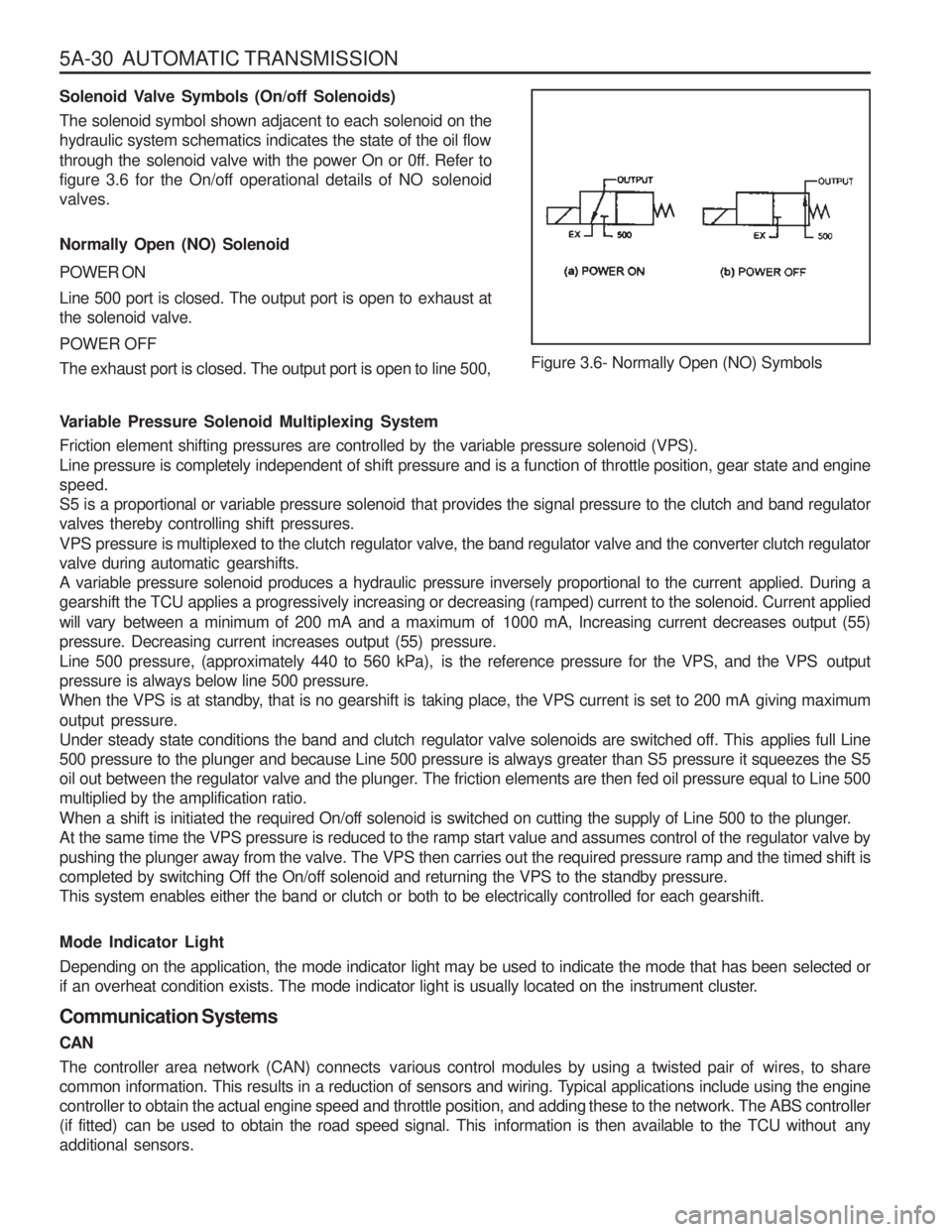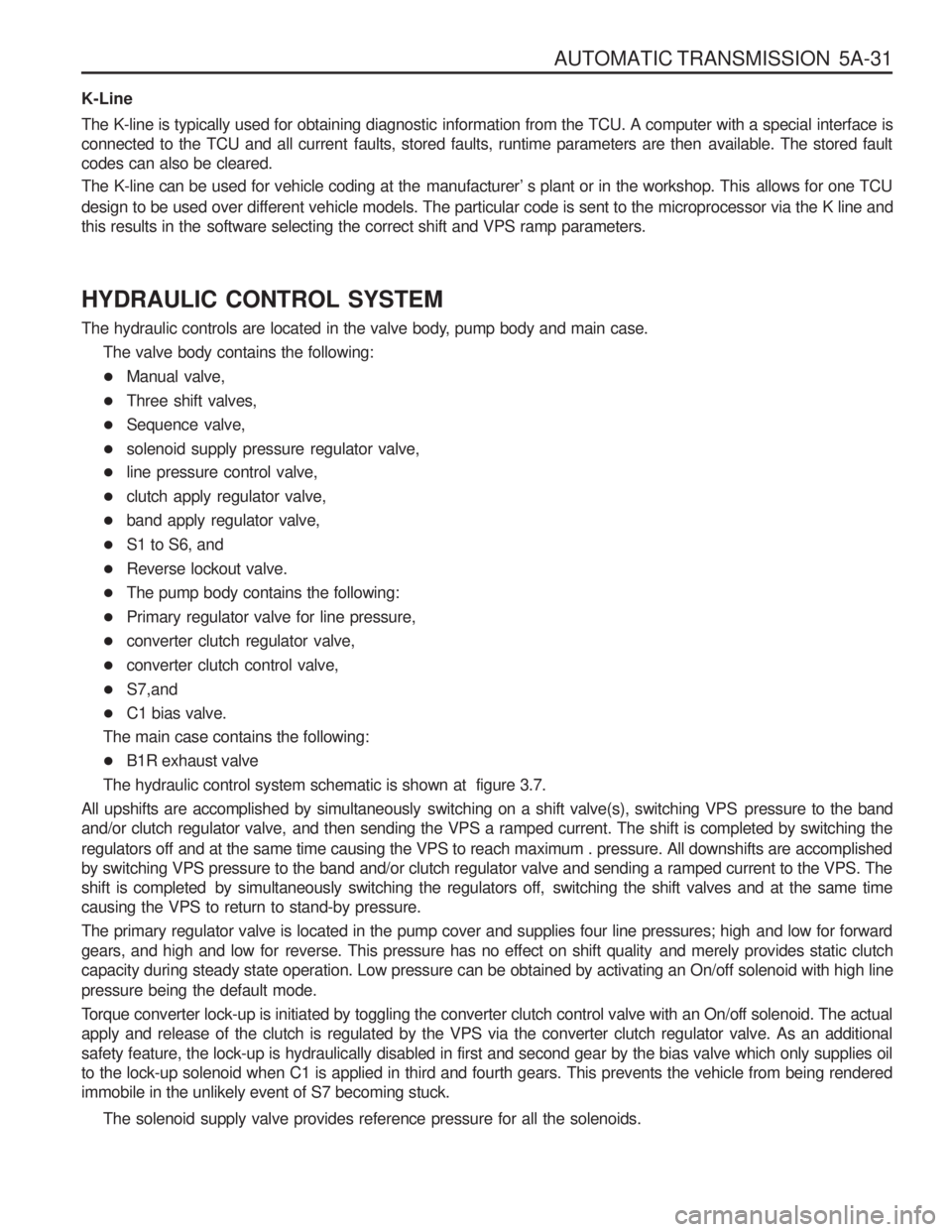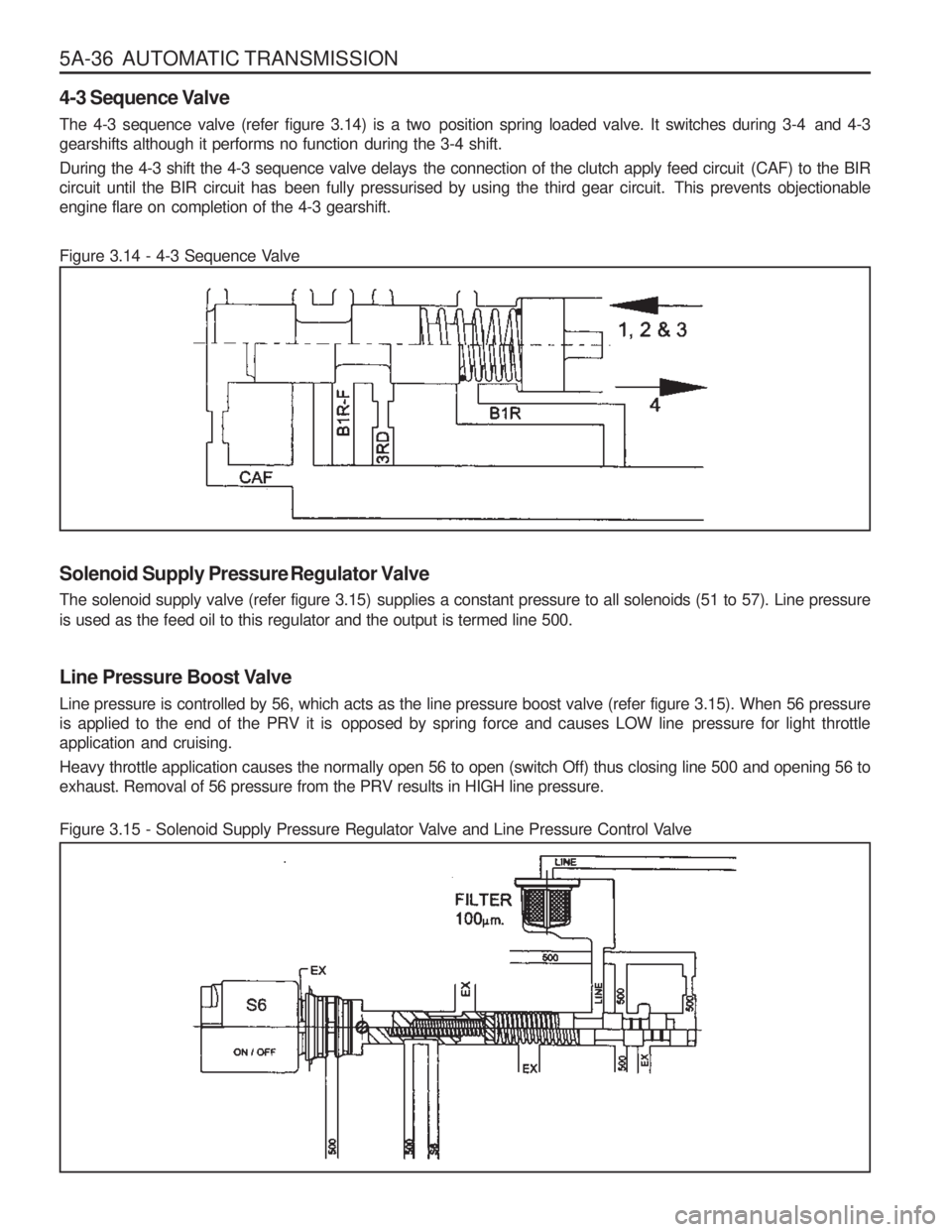2003 SSANGYONG MUSSO solenoid
[x] Cancel search: solenoidPage 888 of 1574

AUTOMATIC TRANSMISSION 5A-29
Table 3.6- Solenoid Operation During Gearshifts
To Initiate Shift
S1 OFF S4 ONS1 OFF S2 OFF S3 ONS4 ONS2 OFF
S3 ON S4 ON S2 OFFS3 ONS4 ONS1 ON S4 ON S4 ON S3 ON S3 ON S4 ON S2 ON S4 ON S3 ON S4 ON S4 ON S7 ON To Complete Shift
S4 OFF S3 OFF S4 OFF S3 OFF S4 OFF S3 OFF S4 OFF S4 OFF S1 OFF S4 OFFS1 OFFS2 ON S3 OFF S2 ONS3 OFFS4 OFFS4 OFF S1 ON S2 ONS3 OFF S4 OFF S1 ONS4 OFF S7 OFFTypical S5 Current Ramp
750mA to 600mA 850mA to 750mA 850mA to 750mA 700mA to 500mA 750mA to 600mA 750mA to 900mA 750mA to 950mA 600mA to 1000mA 600mA to 450mA @ 20 kph. 550mA to 400mA @ 60 kph. 800mA to 650mA @ 100 kph. 700mA to 950mA 800mA to 950mA 700mA to 400mA 600mA to 100mA
Shift
1-2 1-3 1-4 2-3 3-4 4-3 4-2 4-1 3-2 3-1 2-1
Conv. Clutch ON OFF
Page 889 of 1574

5A-30 AUTOMATIC TRANSMISSION
Solenoid Valve Symbols (On/off Solenoids)
The solenoid symbol shown adjacent to each solenoid on the
hydraulic system schematics indicates the state of the oil flow
through the solenoid valve with the power On or 0ff. Refer to
figure 3.6 for the On/off operational details of NO solenoidvalves. Normally Open (NO) Solenoid POWER ON
Line 500 port is closed. The output port is open to exhaust at the solenoid valve. POWER OFF
The exhaust port is closed. The output port is open to line 500,Figure 3.6- Normally Open (NO) Symbols
Variable Pressure Solenoid Multiplexing System
Friction element shifting pressures are controlled by the variable pressure solenoid (VPS).
Line pressure is completely independent of shift pressure and is a function of throttle position, gear state and enginespeed.
S5 is a proportional or variable pressure solenoid that provides the signal pressure to the clutch and band regulator
valves thereby controlling shift pressures.
VPS pressure is multiplexed to the clutch regulator valve, the band regulator valve and the converter clutch regulator
valve during automatic gearshifts.
A variable pressure solenoid produces a hydraulic pressure inversely proportional to the current applied. During a
gearshift the TCU applies a progressively increasing or decreasing (ramped) current to the solenoid. Current applied will vary between a minimum of 200 mA and a maximum of 1000 mA, Increasing current decreases output (55)
pressure. Decreasing current increases output (55) pressure.
Line 500 pressure, (approximately 440 to 560 kPa), is the reference pressure for the VPS, and the VPS outputpressure is always below line 500 pressure.
When the VPS is at standby, that is no gearshift is taking place, the VPS current is set to 200 mA giving maximum output pressure.
Under steady state conditions the band and clutch regulator valve solenoids are switched off. This applies full Line
500 pressure to the plunger and because Line 500 pressure is always greater than S5 pressure it squeezes the S5
oil out between the regulator valve and the plunger. The friction elements are then fed oil pressure equal to Line 500multiplied by the amplification ratio.
When a shift is initiated the required On/off solenoid is switched on cutting the supply of Line 500 to the plunger.
At the same time the VPS pressure is reduced to the ramp start value and assumes control of the regulator valve by
pushing the plunger away from the valve. The VPS then carries out the required pressure ramp and the timed shift is
completed by switching Off the On/off solenoid and returning the VPS to the standby pressure.
This system enables either the band or clutch or both to be electrically controlled for each gearshift. Mode Indicator Light
Depending on the application, the mode indicator light may be used to indicate the mode that has been selected or
if an overheat condition exists. The mode indicator light is usually located on the instrument cluster. Communication Systems CAN
The controller area network (CAN) connects various control modules by using a twisted pair of wires, to share
common information. This results in a reduction of sensors and wiring. Typical applications include using the engine
controller to obtain the actual engine speed and throttle position, and adding these to the network. The ABS controller
(if fitted) can be used to obtain the road speed signal. This information is then available to the TCU without anyadditional sensors.
Page 890 of 1574

AUTOMATIC TRANSMISSION 5A-31
K-Line
The K-line is typically used for obtaining diagnostic information from the TCU. A computer with a special interface is
connected to the TCU and all current faults, stored faults, runtime parameters are then available. The stored faultcodes can also be cleared.
The K-line can be used for vehicle coding at the manufacturer’ s plant or in the workshop. This allows for one TCU
design to be used over different vehicle models. The particular code is sent to the microprocessor via the K line and
this results in the software selecting the correct shift and VPS ramp parameters. HYDRAULIC CONTROL SYSTEM
The hydraulic controls are located in the valve body, pump body and main case.The valve body contains the following:
� Manual valve,
� Three shift valves,
� Sequence valve,
� solenoid supply pressure regulator valve,
� line pressure control valve,
� clutch apply regulator valve,
� band apply regulator valve,
� S1 to S6, and
� Reverse lockout valve.
� The pump body contains the following:
� Primary regulator valve for line pressure,
� converter clutch regulator valve,
� converter clutch control valve,
� S7,and
� C1 bias valve.
The main case contains the following:
� B1R exhaust valve
The hydraulic control system schematic is shown at figure 3.7.
All upshifts are accomplished by simultaneously switching on a shift valve(s), switching VPS pressure to the band
and/or clutch regulator valve, and then sending the VPS a ramped current. The shift is completed by switching the
regulators off and at the same time causing the VPS to reach maximum . pressure. All downshifts are accomplished
by switching VPS pressure to the band and/or clutch regulator valve and sending a ramped current to the VPS. The
shift is completed by simultaneously switching the regulators off, switching the shift valves and at the same timecausing the VPS to return to stand-by pressure.
The primary regulator valve is located in the pump cover and supplies four line pressures; high and low for forward
gears, and high and low for reverse. This pressure has no effect on shift quality and merely provides static clutch
capacity during steady state operation. Low pressure can be obtained by activating an On/off solenoid with high line pressure being the default mode.
Torque converter lock-up is initiated by toggling the converter clutch control valve with an On/off solenoid. The actual apply and release of the clutch is regulated by the VPS via the converter clutch regulator valve. As an additionalsafety feature, the lock-up is hydraulically disabled in first and second gear by the bias valve which only supplies oilto the lock-up solenoid when C1 is applied in third and fourth gears. This prevents the vehicle from being renderedimmobile in the unlikely event of S7 becoming stuck.
The solenoid supply valve provides reference pressure for all the solenoids.
Page 895 of 1574

5A-36 AUTOMATIC TRANSMISSION
4-3 Sequence Valve
The 4-3 sequence valve (refer figure 3.14) is a two position spring loaded valve. It switches during 3-4 and 4-3
gearshifts although it performs no function during the 3-4 shift.
During the 4-3 shift the 4-3 sequence valve delays the connection of the clutch apply feed circuit (CAF) to the BIR
circuit until the BIR circuit has been fully pressurised by using the third gear circuit. This prevents objectionable
engine flare on completion of the 4-3 gearshift.
Figure 3.14 - 4-3 Sequence Valve
Figure 3.15 - Solenoid Supply Pressure Regulator Valve and Line Pressure Control Valve
Solenoid Supply Pressure Regulator Valve
The solenoid supply valve (refer figure 3.15) supplies a constant pressure to all solenoids (51 to 57). Line pressure
is used as the feed oil to this regulator and the output is termed line 500.
Line Pressure Boost Valve
Line pressure is controlled by 56, which acts as the line pressure boost valve (refer figure 3.15). When 56 pressure
is applied to the end of the PRV it is opposed by spring force and causes LOW line pressure for light throttleapplication and cruising.
Heavy throttle application causes the normally open 56 to open (switch Off) thus closing line 500 and opening 56 to
exhaust. Removal of 56 pressure from the PRV results in HIGH line pressure.
Page 897 of 1574

5A-38 AUTOMATIC TRANSMISSION
Reverse Lockout Valve
The reverse lockout valve (refer figure 3.18) is a two position valve contained in the upper valve body. This valve
uses 51-52 pressure as a signal pressure and controls the application of the rear band (B2).
While the manual valve is in D,3,2, or 1 positions, drive oil is applied to the spring end of the valve, overriding any
signal pressures and holding the valve in the lockout position. This prevents the application of B2 in any of theforward driving gears.
When the manual valve is in P, R or N positions, drive oil is exhausted and the reverse lockout valve may be toggled by S1-S2 pressure.B2 is applied in P, R, and N provided that the following conditions are satisfied:
1. In P or N, roadspeed 3 km/h.
2. In R, road speed 10 km/h.
3. Engine speed 1400 rpm.
4. For diesel vehicles, throttle 25%.
5. For gasoline vehicles, throttle 12%.
Under these conditions, the TCU switches solenoids S1 and S2 to Off. The reverse lockout valve toggles under the
influence of the S1-S2 pressure, to connect the line pressure to the B2 feed. Oil is fed to both the inner and outer
apply areas of the rear servo piston, applying B2.
If any of the above conditions are not satisfied, the TCU switches solenoids S1 and S2 to On. S1- S2 pressure is
exhausted and the valve is held in the lockout position by the spring. In this position, engagement of B2 is prohibited.
This feature protects the transmission from abuse by preventing the undesirable application of B2 at high speed, and
by providing a reverse lockout function.
Note that if the transmission is in failure mode, the rear band will be applied at all times in P, R and N.
Figure 3.18 - Reverse Lockout Valve <
<
<
<
<
Page 907 of 1574

5A-48 AUTOMATIC TRANSMISSION POWER FLOW - PARK AND NEUTRAL
In Park and Neutral, there is no drive to the planetary gear set. The rear band is applied to eliminate ‘clunk’ on
engagement of the reverse gear, and to improve the low range engagement for 4WD applications. No other clutches
or bands are applied.
In Park the transmission is mechanically locked by engaging a case mounted pawl with teeth on the output shaft ring
gear. Control
To maintain this arrangement in the steady state solenoids and valves are activated as follows:
� Solenoids S1 and S2 are switched off.
� Line (pump) pressure is applied to the primary regulator valve (PRV) and to the solenoid supply valve.
� The converter, oil cooler, and lubrication circuits are charged from the primary regulator valve.
� The line 500 circuit is charged by the solenoid supply valve.
� The S5 circuit is charged by the variable pressure solenoid (S5).
� Line pressure is prevented from entering the drive circuit by the manual valve.
� The B1 circuit and all clutch circuits are open to exhaust.
Refer to figure 5.1 and table 5.2.
Table 5.2 - Engaged Elements - Park arid Neutral
Gear State
Park and Neutral C1
- C2
- C3
- C4
- B1
- B2
X 1-2
OWC - 3-4
OWC - LU
CLUTCH -
ELEMENTS ENGAGED
Page 908 of 1574

AUTOMATIC TRANSMISSION 5A-49
POWER FLOW - REVERSE
In Reverse, transmission drive is via the input shaft and the forward clutch cylinder to the hub of the C3 clutch. The
elements of the transmission function as follows :� The C3 clutch is engaged and drives the reverse sun gear in a clock-wise direction.
� The B2 band is engaged and holds the planetary gear carrier stationary causing the long pinion to rotate anti-
clockwise about its axis on the pinion shaft.
� The long pinion drives the internal ring fear in the same direction.
� The internal ring being splined to the output shaft drives it in an anti-clockwise or reverse direction.
Control
To maintain this arrangement in the steady state solenoids and valves are activated as follows: � Solenoids S1 and S2 are switched off.
� Line pressure is directed through the reverse lockout valve to both the inner and outer apply areas of the rear
servo piston for B2 band application.
� Line pressure feeds the reverse oil circuit via the manual valve.
� Reverse oil is routed from the manual valve to the C3 clutch.
� Reverse oil is also applied to the spring end of the primary regulator valve to assist the spring and to boost theline pressure value.
� All other clutch and band apply circuits are open to exhaust.
Refer to figure 5.2 and table 5.3
Table 5.3 - Engaged Elements - Reverse
Gear State
Reverse C1
- C2
- C3
X C4
- B1
- B2
X 1-2
OWC - 3-4
OWC - LU
CLUTCH -
ELEMENTS ENGAGED
Page 909 of 1574

5A-50 AUTOMATIC TRANSMISSION POWER FLOW - MANUAL 1 In Manual 1, transmission drive is via the input shaft
to the forward clutch cylinder. The elements of thetransmission function as follows :� The C2 clutch is engaged to drive the forward sun gear, via the 3-4 OWC.
� The B2 band is engaged to hold the planetary gear carrier stationary.
� The forward sun gear drives the short pinion anti-clockwise.
� The short pinion drives the long pinion clockwise.
� The long pinion rotating about its axis drives the internal ring gear and the output shaft in a clockwise or
forward direction.
� The C4 clutch provides engine braking through the 3-4 OWC on overrun.
Control
To maintain this arrangement in the steady state solenoids and valves are activated as follows: � Solenoids S1 and S2 are switched ON.
� The 1-2,2-3, and 34 shift valves are held in their first gear positions by line 500 pressure.
� Drive (line pressure) oil from the manual valve engages the C2 clutch.
� Lo-1st (line pressure) oil is routed through the 1-2 shift valve to the C4 clutch, and to the inner apply area of
the rear servo piston for B2 band application.
Refer to figure 5.3 and table 5.4.
Table 5.4 - Engaged Elements - Manual 1
Gear State
Manual 1 C1
- C2
X C3
- C4
X B1
- B2
X 1-2
OWC - 3-4
OWC X LU
CLUTCH -
ELEMENTS ENGAGED